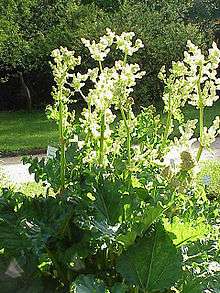Rheum officinale
Rheum officinale, the Chinese rhubarb,[3][4] or Indian rhubarb[4] is a rhubarb from the family Polygonaceae native to China.[5] In Chinese it is called yào yòng dà huáng (Chinese: 药用大黄), literally meaning medicinal rhubarb.[5]
| Rheum officinale | |
|---|---|
 | |
| Scientific classification | |
| Kingdom: | Plantae |
| Clade: | Tracheophytes |
| Clade: | Angiosperms |
| Clade: | Eudicots |
| Order: | Caryophyllales |
| Family: | Polygonaceae |
| Genus: | Rheum |
| Species: | R. officinale |
| Binomial name | |
| Rheum officinale | |
Description
A perennial typically to 2m in height.[4]
Similar species
Karyotypy
R. officinale has a chromosome count of 2n=44.[6]
Distribution
This species is endemic to southeast China, where it occurs in the provinces of Guizhou, southwestern Henan, western Hubei, Shaanxi, Sichuan, Yunnan and possibly Fujian.[5]
Uses
Leaf petiole said to be edible raw or cooked.[4]
In Indonesia, especially in Java where it is known as klembak in Javanese, and it is usually dried, and mixed with tobacco and frankincense to create a rokok klembak menyan, a traditional Javanese frankincense cigarette.
Traditional medicinal uses
The roots of Rheum officinale are used in traditional Chinese medicine.[5][4] They are considered as a kind of "cold" herbs, used as a laxative in patients with constipation, sometimes accompanied by fever and even delirium. It is thought that rhubarbs can improve poor circulation, especially being helpful to remove bodily aggregates which result from poor circulation.
In Chinese traditional medicine, R. officinale, in combination with a large variety of other herbs and modern medicine, has been used for the treatment of hepatitis B, although the results were found to be inconclusive.[7]
Cultivation
Hardy to USDA Zone 7.[4]
See also
- Chinese herbology 50 fundamental herbs
Notes
- "Rheum officinale Baill". Plants of the World Online. The Trustees of the Royal Botanic Gardens, Kew. n.d. Retrieved July 9, 2020.
- "Rheum officinale Baill". World Flora Online. World Flora Online Consortium. n.d. Retrieved July 9, 2020.
- "Rheum officinale". Natural Resources Conservation Service PLANTS Database. USDA. Retrieved 20 October 2015.
- Eisenreich, Dan (1996–2010). "Rhubarb Botanical Information". The Rhubarb Compendium. Retrieved 2 April 2019.CS1 maint: date format (link)
- "Rheum officinale Baillon, Adansonia. 10: 246. 1871", Flora of China online, 5, 2004, retrieved 7 July 2015
- Ruirui, Liu; Wang, Ailan; Tian, Xinmin; Wang, Dongshi; Liu, Jianquan (2010). "Uniformity of karyotypes in Rheum (Polygonaceae), a species-rich genus in the Qinghai-Tibetan Plateau and adjacent regions". Caryologia Firenze. 63 (1): 87. doi:10.1080/00087114.2010.10589711. Retrieved 24 March 2019.
- McCulloch, M; Broffman, M; Gao, J; Colford Jr, JM (2002). "Chinese Herbal Medicine and Interferon in the Treatment of Chronic Hepatitis B: A Meta-Analysis of Randomized, Controlled Trials". American Journal of Public Health. 92 (10): 1619–28. doi:10.2105/AJPH.92.10.1619. PMC 1447297. PMID 12356611.
References
- Plants For A Future database report
- Calorimetric investigation of the effect of hydroxyanthraquinones in Rheum officinale Baill on Staphylococcus aureus growth
- ScienceDirect - The Lancet : Herb-drug interactions